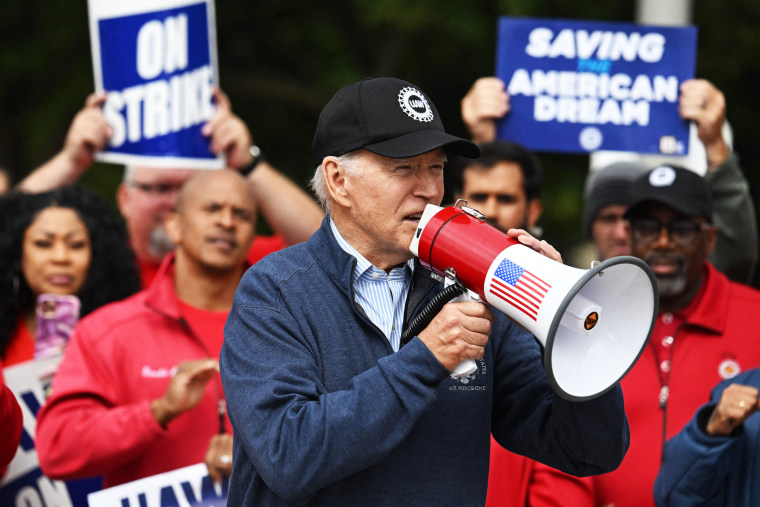In September, as UAW members went on strike at multiple auto plants across the country, both President Joe Biden and former President Donald Trump sought to capitalize on the moment. Biden joined the picket line in Belleville, Michigan, near Detroit, signaling his support for labor, while Trump gave a rally at a nonunion auto parts manufacturer, also near Detroit, blasting Biden’s electric vehicle policies and calling on union leaders to endorse him. Each was trying to signal that he was on the side of “the working class.” Importantly, each had a different idea of what “the working class” is and how essential it is to presidential victories.
Saying that ‘the working class’ has abandoned the Democrats is highly misleading.
Democrats and Republicans have shifted their coalitions a lot over the past 50 years, and even during the past 10. Understanding how can be tricky, and saying, as many have, that “the working class” has abandoned the Democrats is highly misleading. Some recent studies argue that working class voters moved away from Democrats because of the party’s economic policies, but this ignores that the portion of the working class that moved away was overwhelmingly white. The changing demographics of the Democratic Party, then, isn’t a story about economics; it’s a story about race.
Fifty years ago, when Democrats were still benefiting from high opinions of the New Deal and low opinions of Republicans lingering from the Great Depression, the party was a hodgepodge of people we wouldn’t normally expect to see voting together. There were, among others, white segregationists in the South, civil rights advocates in the North, liberal Black people, conservative white people, rural farmers and big-city machine bosses. It’s impressive that such an unlikely coalition lasted for as long as it did.
The passage of the Civil Rights Act in 1964 and Voting Rights Act in 1965 put great strain on this coalition, and while white Southerners still mainly thought of themselves as Democrats for long-standing historical reasons, many increasingly felt the party was hostile to the vision they had of the nation and its racial hierarchy. The tension finally snapped in the tumultuous year of 1968 when former Alabama Gov. George Wallace, an infamous segregationist, ran for president on a “law and order” platform and inveighed against rising crime rates, school busing and people he saw as “communists” or “un-American.” He garnered an impressive 13.5% of the popular vote as a third-party candidate, winning five states in the Deep South and the support of a lot of racist white people outside the South, as well.
In 1972, Republican Richard Nixon, who won the 1968 election over Democrat Hubert Humphrey, commissioned several studies that found that working class voters had significant economic anxiety about stagnant wages and benefits, and resentment toward people of color and educated protesters. Nixon largely, though not completely, ignored the first concern and leaned in hard on the second.
“White Democrats,” Nixon advisor Kevin Phillips argued, “will desert their party in droves the minute it becomes a black party. When white Southerners move, they move fast.” He said the secret of politics is “knowing who hates who.”
Nixon’s approach of courting white ethnics, of campaigning on “law and order” as George Wallace did, and of reaching out to white country musicians like Merle Haggard was to speak to disaffected white voters rather than largely newly enfranchised Black voters.
Nixon found common ground with union leaders on culture war issues by, for example, appealing to their disdain for hippies and anti-war protesters. Strikingly, the AFL-CIO did not endorse either party’s presidential nominee in 1972, and thus paved the way for a substantial white working class defection to Nixon, who won in one of the largest landslides in American history.
The AFL-CIO did not endorse either party’s presidential nominee in 1972, and thus paved the way for a substantial white working class defection to Nixon
Ronald Reagan enthusiastically followed Nixon’s method of speaking to white voters frighted by racial and cultural changes without explicitly mentioning race. Instead, he campaigned against “welfare queens” and delivered a speech expressing his support for states’ rights in Neshoba County, Miss., where three civil rights workers had been kidnapped and brutally murdered.
While the realignment of the parties didn’t occur all at once, we see the results today. The 1968 and 2020 presidential elections were similarly close, but according to the American National Election Studies, in 1968, 52% of white people who never attended college voted for the Democratic candidate, and in 2020, just 35% did. Between 1968 and 2020, there was some slight movement away from the Democrats among voters who aren’t white and aren’t college educated, but the bulk of the movement was among white voters who aren’t college educated.
Overall, trends suggest that the Democrats are still the party of poorer people, most people of color and, increasingly, college-educated whites, while the Republicans are the party, somewhat paradoxically, of white people without college education and white people who are wealthy. And in an era where presidential elections are won by just a few tens of thousands of votes across a handful of swing states, it doesn’t take much shifting to make all the difference in the world.
That’s why Trump and Biden were in the swing state of Michigan. Each is trying to convince working class voters there that he’s on their side.
